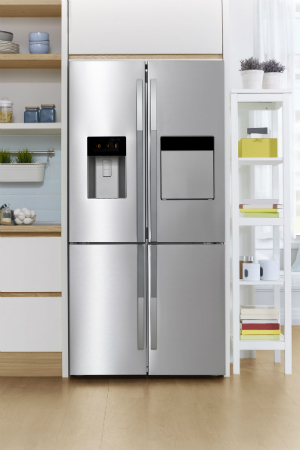We may earn revenue from the products available on this page and participate in affiliate programs. Learn More ›
The refrigerator is arguably the most important major appliance in the kitchen, and it’s often the most expensive one as well. Because you naturally want the best performance from your fridge, why not extend its life and increase its efficiency by periodically cleaning its condenser coils?
Located at the base of the fridge, or behind it, depending on age and brand of the unit, these coils are filled with refrigerant that cools the air inside. Condenser coils are exposed, not in a sealed casing, and therefore vulnerable to dust buildup. Dirty coils force a fridge to work harder keeping food cold, resulting in higher energy costs and a reduced lifespan for the pricey appliance.
Fortunately, cleaning your refrigerator’s condenser coils is a simple task for do-it-yourselfers. Put it on the calendar to complete at least once a year, or twice a year if you have pets that shed. Keep reading to find out just how to clean refrigerator coils—and how easy it is to help keep your fridge functioning at its peak.
Tools & Materials
Bobvila.com may earn a commission from purchases made through these links.
Step 1
Unplug the unit (the first rule of any appliance maintenance, upkeep, or repair job). This may require pulling your refrigerator out from the wall if the power outlet is located behind it. Don’t worry about spoilage: The coil-cleaning process is quick (15 minutes or less) and the doors will remain closed, so your cold foods will keep.

Step 2
Locate the condenser coils at the base of the fridge in front, behind a toe-grill that snaps off. If your fridge doesn’t have a toe-grill, you’ll find the condenser coils located on the back of the refrigerator. Condenser coils are metal tubes, wound in a U-shaped grid pattern. If the refrigerator’s coils are on the back, you’ll need to pull the fridge fully away from the wall to clean them.
Step 3
Don a dust mask. (Most dust/debris will get vacuumed up, but some will no doubt become airborne.) Using a flashlight to help you see the coils if they’re located beneath the fridge, vacuum loose dust and debris along the inside of the toe grill or from the backside of the fridge.
Step 4
Brush away the dust with a coil condenser brush, which you can find for about $10 from DIY stores. Measuring approximately 27 inches long with short bristles on the top one-third, its cylindrical design lets you easily slip it between the spaces in the coil grid. Work it back and forth to remove dust, and try gently twisting it to get into corners and tight spots. Keep the vacuum running as you brush. If cleaning coils located on the back of the fridge, hold the narrow end of the nozzle close to the brush with one hand and brush with the other. If cleaning coils at the base of the fridge, it’s easier to alternate brushing and then vacuuming up the dust.
Step 5
Vacuum any errant dust that might have gotten on the floor. Replace the toe-grill (it should snap on easily) and push the fridge back in place if necessary. Plug your refrigerator’s power cord back in, and you’re good to go!


